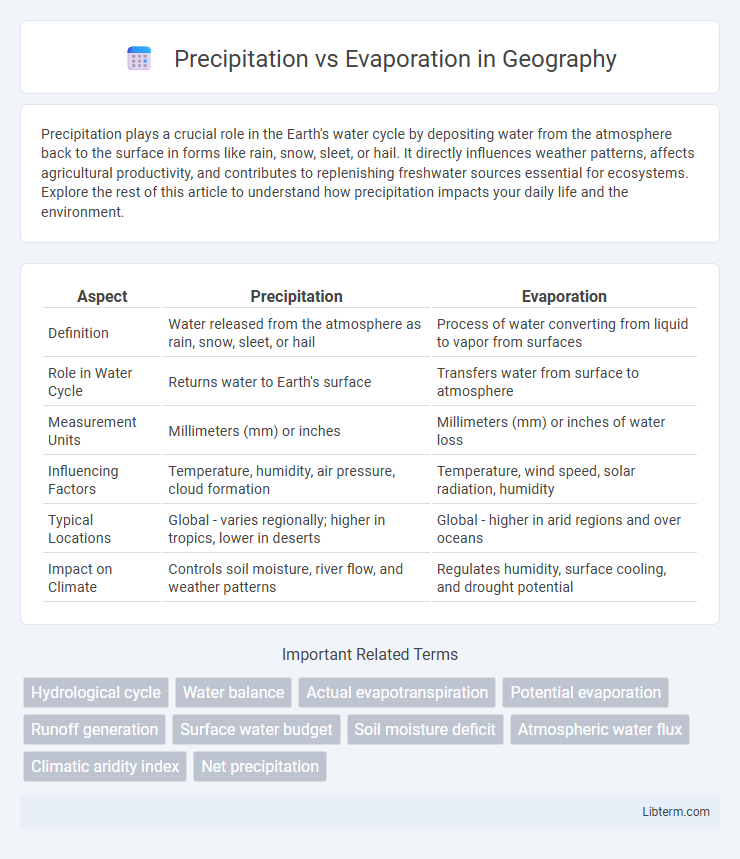Precipitation plays a crucial role in the Earth's water cycle by depositing water from the atmosphere back to the surface in forms like rain, snow, sleet, or hail. It directly influences weather patterns, affects agricultural productivity, and contributes to replenishing freshwater sources essential for ecosystems. Explore the rest of this article to understand how precipitation impacts your daily life and the environment.
Table of Comparison
| Aspect | Precipitation | Evaporation |
|---|---|---|
| Definition | Water released from the atmosphere as rain, snow, sleet, or hail | Process of water converting from liquid to vapor from surfaces |
| Role in Water Cycle | Returns water to Earth's surface | Transfers water from surface to atmosphere |
| Measurement Units | Millimeters (mm) or inches | Millimeters (mm) or inches of water loss |
| Influencing Factors | Temperature, humidity, air pressure, cloud formation | Temperature, wind speed, solar radiation, humidity |
| Typical Locations | Global - varies regionally; higher in tropics, lower in deserts | Global - higher in arid regions and over oceans |
| Impact on Climate | Controls soil moisture, river flow, and weather patterns | Regulates humidity, surface cooling, and drought potential |
Introduction to Precipitation and Evaporation
Precipitation occurs when water vapor in the atmosphere condenses into droplets or ice crystals that fall to the Earth's surface as rain, snow, sleet, or hail. Evaporation is the process by which liquid water from oceans, lakes, and soil converts into water vapor, rising into the atmosphere. These two processes are crucial components of the hydrological cycle, balancing the distribution of water between the Earth and atmosphere.
Defining Precipitation: Mechanisms and Types
Precipitation occurs when atmospheric water vapor condenses into droplets or ice crystals that grow heavy enough to fall to the Earth's surface. Key mechanisms include condensation around condensation nuclei and the collision-coalescence process, which influence the formation of rain, snow, sleet, hail, and drizzle. Different types of precipitation depend on temperature profiles and atmospheric conditions, impacting hydrological cycles and climate systems globally.
Understanding Evaporation: Processes and Factors
Evaporation is the transformation of water from liquid to vapor driven by solar energy, temperature, humidity, wind speed, and surface area. Higher temperatures and wind speeds accelerate evaporation rates, while increased humidity slows the process. Understanding these factors is essential for accurate hydrological modeling and managing water resources in agriculture and climate studies.
The Water Cycle Connection
Precipitation and evaporation are critical processes in the water cycle, driving the continuous movement of water between the atmosphere, land, and oceans. Precipitation returns water from clouds to Earth's surface as rain, snow, or sleet, replenishing soil moisture and surface water bodies. Evaporation transforms surface water into vapor, transferring moisture back into the atmosphere and sustaining cloud formation essential for ongoing precipitation.
Key Differences Between Precipitation and Evaporation
Precipitation involves the process where water vapor condenses and falls to the Earth's surface as rain, snow, sleet, or hail, directly contributing to the hydrological cycle's input. Evaporation, on the other hand, is the transformation of liquid water from oceans, lakes, and soil into water vapor, representing a critical output in the water cycle. The key difference lies in precipitation being a liquid or solid phase transition downward, while evaporation is a phase change from liquid to gas moving upward into the atmosphere.
Climatic Impacts of Precipitation and Evaporation
Precipitation influences climatic conditions by regulating water availability and affecting temperature through latent heat release during condensation, which impacts atmospheric circulation patterns. Evaporation drives the hydrological cycle by transferring moisture from surfaces to the atmosphere, cooling the environment and influencing humidity levels critical for cloud formation. The balance between precipitation and evaporation determines regional climate stability, soil moisture content, and ecosystem productivity.
Measurement Techniques for Precipitation and Evaporation
Rain gauges, including tipping bucket and weighing types, are primary instruments for measuring precipitation by collecting and quantifying rainfall amounts accurately. Evaporation is commonly measured using pan evaporation methods like the Class A evaporation pan or more advanced techniques such as lysimeters and Eddy covariance systems that assess water loss through evaporation and transpiration. Accurate measurements of both precipitation and evaporation are essential for hydrological modeling, water resource management, and climate studies.
Human Influence on Precipitation and Evaporation Patterns
Human activities such as deforestation, urbanization, and greenhouse gas emissions significantly alter precipitation and evaporation patterns by changing local atmospheric conditions and land surface properties. Increased greenhouse gases enhance the greenhouse effect, raising global temperatures and accelerating evaporation rates, which intensify the water cycle and modify precipitation distribution. Urban heat islands caused by infrastructure development contribute to localized changes in precipitation by increasing convection and altering humidity levels.
Environmental and Ecological Consequences
Precipitation replenishes freshwater ecosystems and supports plant growth, while evaporation regulates atmospheric moisture and temperature. Imbalances between precipitation and evaporation can lead to droughts, reduced soil fertility, and habitat loss, impacting biodiversity and agricultural productivity. These changes disrupt ecosystem services such as carbon sequestration and water purification, intensifying climate change effects and threatening environmental stability.
Conclusion: Balancing Earth’s Water Dynamics
Precipitation and evaporation maintain Earth's water balance by regulating the continuous exchange between the atmosphere and surface. When precipitation exceeds evaporation, water accumulates in rivers, lakes, and soil, supporting ecosystems and human needs. Conversely, higher evaporation rates reduce surface water, impacting climate patterns and water availability, highlighting the critical role of this dynamic equilibrium in sustaining Earth's hydrological cycle.
Precipitation Infographic

 libterm.com
libterm.com